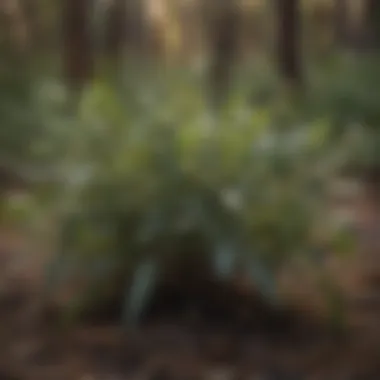Mastering Eucalyptus Cuttings: Techniques and Tips


Intro
Eucalyptus, with its distinctive aroma and vibrant foliage, often captures the imagination of those in the field of forestry and horticulture alike. While its beauty is widely acknowledged, the methods of propagating this cherished plant often remain underappreciated. The journey of eucalyptus cuttings offers a fascinating intersection of art and science, inviting both professionals and amateurs alike to tap into nature’s ingenuity.
As climate change continues to challenge the ecological balance, the significance of incorporating trees like eucalyptus into American forestry becomes increasingly apparent. This article serves as a detailed guide on how to effectively propagate eucalyptus through cuttings, emphasizing practical techniques and ideal conditions that foster successful growth.
In the sections that follow, we will explore the types of eucalyptus suitable for cuttings, the conditions they thrive in, and the ecological benefits they offer. Challenges in cultivation will also be scrutinized, alongside effective solutions for overcoming them.
By laying out these insights, we hope to equip horticulturists, scientists, and enthusiasts with the knowledge necessary to incorporate those striking trees into their landscapes, ultimately creating greener spaces that not only beautify but also benefit the environment.
Let’s embark on this exploration of eucalyptus, one cutting at a time.
Preamble to Eucalyptus Cuttings
Eucalyptus cuttings represent not just a method of propagation, but a blend of art and science vital to ecological sustainability and forestry practices. As we delve into the world of eucalyptus, we uncover the significance of understanding how to effectively create new plants through cuttings. This technique is not only beneficial for horticulturists and landscapers, but it also plays a pivotal role in reforestation efforts, particularly in regions grappling with deforestation.
The practice of taking cuttings offers some distinct advantages. It allows for the replication of specific varieties that may possess desirable traits such as drought tolerance or rapid growth. Furthermore, eucalyptus trees are notable for their ability to thrive in various conditions, making them a valuable addition to numerous landscapes. By mastering eucalyptus cuttings, growers can better manage genetic diversity while fostering a more resilient ecosystem.
The journey into eucalyptus cuttings begins with a thorough understanding of the eucalyptus species themselves. These trees, native primarily to Australia, showcase a variety of forms and sizes, each with unique characteristics. In this article, we will explore the fundamentals of eucalyptus propagation and the methods that contribute to a successful cultivation process.
Understanding Eucalyptus
Eucalyptus trees encompass a vast genus with over seven hundred species, each showing remarkable adaptation to their surroundings. Their ethereal beauty, tall stature, and aromatic leaves are just a few of the reasons why gardeners and environmentalists alike are drawn to them. These evergreens are known to be fast growers, often reaching mature heights within a short timeframe, which can be particularly advantageous for those looking for quick landscape solutions.
Many eucalyptus species exhibit beautiful bark that flakes off in long strips, revealing vibrant colors underneath. Their leaves, often characterized by a long, slender shape, can have various textures and colors, depending on the species. The leaves of eucalyptus plants release a distinct scent, which has made them popular for their essential oils, utilized across aromatherapy and perfumery. However, it's not just their aesthetic appeal that makes them important; their role in the ecosystem is equally crucial as they provide habitat and food for various wildlife.
Eucalyptus trees are vital to their native ecosystems, supporting many species and contributing to soil health and water retention. Therefore, when considering the planting of eucalyptus, it is essential not only to look at the tree's visual appeal but also at its influence on local biodiversity.
History and Origin
Historically, the eucalyptus is tightly knit with the narrative of Australian ecosystems, where it has flourished for millions of years. Many indigenous Australian communities have had long-standing relationships with eucalyptus trees, utilizing their leaves and bark for medicinal properties. The trees were brought to other parts of the world in the 19th century, mainly for their timber, which is remarkably strong yet lightweight.
During this period, eucalyptus trees were planted extensively in California and other parts of the world, often as windbreaks or for erosion control. However, the introduction of these trees was not without controversy, as their rapid growth and consumption of water raised concerns about their ecological impact in non-native areas.
Today, the acknowledgement of both the environmental benefits and challenges associated with eucalyptus cultivation presents a complex but fascinating topic. Enthusiasts and professionals involved in forestry must consider not just the practical aspects of propagation like cuttings, but also the broader implications for surrounding ecosystems and local climates.
As we move deeper into the process of cutting propagation for eucalyptus, let’s keep in mind the importance of not only taking cuttings but ensuring we do so responsibly and ethically to foster a future where eucalyptus flourishes alongside diverse plant life.
The Propagation Process
The propagation process is at the heart of cultivating eucalyptus through cuttings. This process doesn't merely involve snipping off a branch and sticking it in the soil; it’s a delicate dance that calls for precision, knowledge, and care. Without understanding the nuances of propagation, even the most seasoned horticulturists can face challenges that hinder their efforts. The right approach can lead not only to a thriving plant but also to significant ecological benefits and economic advantages.
Choosing the Right Cuttings
Selecting the proper cuttings is crucial for success. Not all eucalyptus branches are created equal. The ideal cutting usually comes from healthy, mature eucalyptus trees, typically taken from semi-hardwood or firm wood. Here are key factors to consider when choosing cuttings:
- Health of the Parent Plant: Ensure the tree looks robust. A sickly parent can yield weak cuttings.
- Time of Year: Late spring to early summer is often recommended as it aligns with the natural growth cycle of eucalyptus.
- Type of Eucalyptus: Various eucalyptus species have different rooting potentials. Familiarize yourself with which types thrive best in your conditions.
By carefully selecting your cuttings, you're setting the stage for a successful propagative journey.
Techniques for Cutting Preparation
Once the right cuttings are chosen, the next step is preparation. How you prepare those cuttings can make or break the propagation process.


Sterilization Methods
Sterilization is often overlooked but is vital for ensuring the vitality of your cuttings. Pathogens lurking in soil or on plant surfaces can wreak havoc on your newly taken cuttings. A popular sterilization method involves using a mixture of bleach and water to disinfect tools and containers.
- Key Characteristic: This method effectively eliminates harmful bacteria and fungi.
- Why It's Beneficial: Preventing diseases from taking hold increases the likelihood of roots forming and plants thriving.
- Unique Feature: The mixture can easily be prepared at home, making it accessible to anyone interested in propagation.
However, be cautious. Overuse of bleach can damage tissues. Thus, it's essential to find a balance.
Cutting Length and Node Importance
The length of your cuttings, as well as the presence of nodes, are significant determinants in the rooting process. Ideally, cuttings should be around six to ten inches long and include at least two or three nodes.
- Key Characteristic: Nodes are the growth points from which new roots will emerge.
- Why It's Popular: Using cuttings that have multiple nodes makes it more likely that at least one will root successfully.
- Unique Feature: Cutting too short or too long can affect the moisture uptake and rooting success.
Make sure that while cutting, the cut is angled correctly. A clean diagonal cut encourages better absorption.
Rooting Hormones: Do They Matter?
Rooting hormones can be a controversial topic among horticulturists. Some swear by them, while others find them unnecessary.
These hormones, which can be purchased in powder or liquid form, support the rooting process by enhancing the plant's natural capabilities to generate roots. They can be beneficial, especially for those less experienced with propagation. Here are some considerations:
- Usage: Even a small dipping of the cut end into rooting hormone before planting can increase success rates.
- Effectiveness: Fastens the development of roots, allowing plants to establish themselves quickly.
- Disadvantages: Some argue that using hormones might breed dependency on synthetic aids, rather than honing natural propagation skills.
Establishing a solid foundation in propagation can lead to better growth outcomes and a more sustainable approach to utilizing eucalyptus in various landscapes.
Ideal Conditions for Eucalyptus Cuttings
Creating the right environment for eucalyptus cuttings is crucial for their successful propagation. These conditions directly influence the survival and growth rates of the cuttings. If you think about it, providing suitable conditions can be the difference between a thriving eucalyptus plant and one that struggles or fails altogether. Therefore, understanding the elements that contribute to ideal conditions is vital for anyone aiming to cultivate these beautiful trees effectively.
Light Requirements
Light plays an essential role in the health of eucalyptus cuttings. While they enjoy bright light, there’s a catch. Too much direct sunlight might scorch their delicate leaves. Ideally, eucalyptus cuttings should receive filtered light for a significant portion of the day. A position near a south-facing window can work wonders for indoor propagation, allowing ample light without the harshness of direct sun.
- Tip: Use sheer curtains to diffuse intense sunlight.
- Key Points: Bright, indirect light aids photosynthesis, which is necessary for root development. Too little light can lead to weak, leggy growth, making the plant more prone to diseases.
Soil and Water Needs
Soil Composition
When it comes to soil composition, eucalyptus thrives in well-draining mixes that avoid waterlogging. A suggested blend would be a combination of potting soil, perlite, and coarse sand. This mixture ensures that moisture is retained adequately while simultaneously allowing excess water to drain away.
- Why This Blend? The key characteristic here is drainage.
- Unique Advantage: The perlite promotes aeration, which is essential since roots need oxygen to develop properly. If you're trying to mimic eucalyptus' native, free-draining conditions, this mix shines as a strong choice.
Watering Frequency
Gauging the right watering frequency can be a bit tricky but is critical. Generally, eucalyptus cuttings prefer to dry out a bit between waterings; this encourages root systems to grow deeper in search of moisture. Overwatering can lead to root rot, which is a real threat to young cuttings.
- Balanced Approach: Water only when the top inch of soil feels dry.
- Unique Feature: This approach not only promotes robust roots but also reduces the risk of disease.
Temperature and Humidity Levels


Lastly, maintaining appropriate temperature and humidity is non-negotiable. Eucalyptus prefers a warm environment—ideally between 65°F and 75°F. Low humidity can spell doom for them, making misting or using a humidity dome a popular approach among many gardeners.
In summary, mastering the ideal conditions for eucalyptus cuttings—light, soil, moisture, temperature, and humidity—can pave the way for successful propagation. With the right setup, these cuttings hold immense potential to flourish into strong, resilient plants that contribute positively to both landscapes and ecosystems.
Timing for Taking Cuttings
When it comes to propagating eucalyptus through cuttings, timing is everything. Understanding the right moment to take cuttings can set the stage for successful growth and lead to vigorous, healthy plants. Picking the right time is like choosing the perfect moment to catch a wave—if you miss it, you might just find yourself floundering on the shore.
Seasonal Factors
The seasons play a crucial role in the success of eucalyptus cuttings. Generally, late spring to early summer is regarded as the prime time for taking cuttings. During this period, the tree's growth is robust, and the sap is flowing. This is when the plant is highly energetic, making it much likelier that the cuttings will root successfully.
- Spring: In this season, the budding foliage and warmer temperatures provide the ideal backdrop for new growth. Eucalyptus trees being deciduous or evergreen in many cases mean that they might show varying behaviors depending on their species. Watching for the swelling of buds can be a good cue.
- Summer: If you’ve missed the spring window, early summer still presents favorable conditions. Young, semi-hardwood cuttings—those that have hardened a bit but are still flexible—are your best bet. These tend to root quicker and adapt more readily than older, hardwood cuttings.
- Fall and Winter: Taking cuttings during these seasons is generally not recommended. The plants are entering a state of dormancy, which means their energy is redirected away from producing roots. If cuttings are taken during this period, they may not have the vitality needed for successful rooting processes.
Growth Stages of Eucalyptus
Understanding the growth stages of eucalyptus can further refine your timing. Each stage comes with its unique characteristics, which informs the best practices for propagating from cuttings.
- Juvenile Stage: This is when cuttings taken from juvenile foliage tend to root most effectively. The leaves are small and round, and the stem is supple. Cuttings can be taken just before the plant begins to transition toward a more mature state.
- Mature Stage: As the tree matures, the leaves change shape, growing longer and more pointed. Cuttings taken during this stage can still root but may pose challenges. The lignified wood makes rooting more difficult, so patience is required.
- Flowering Stage: During flowering, the energy shifts from growth to reproduction. Cuttings taken at this point may struggle because the plant prioritizes flower production over new roots. Ideally, wait until after flowering has occurred.
"Taking cuttings is both an art and a science; you’ve got to know your plant and nature’s rhythm to succeed."
Common Challenges
Understanding the common challenges faced in propagating eucalyptus cuttings is vital for any serious horticulturist or forestry specialist. These challenges can significantly influence the outcome and success rate of your cuttings, making it crucial to address them proactively. With eucalyptus being prized for its rapid growth and adaptability, neglecting these hurdles can lead to frustrating setbacks.
Pest and Disease Management
One of the core challenges in managing eucalyptus cuttings is the threat posed by pests and diseases. Certain pests, such as scale insects and aphids, can infest your cuttings if not monitored closely. Not only do they sap vital nutrients, but they can also transmit diseases that may hinder the growth of your cuttings, or worse, kill them.
Integrated Pest Management (IPM)
To effectively combat these threats, employing an Integrated Pest Management strategy is essential. Here’s how:
- Regular Inspection: Frequently check your cuttings for any signs of pests or disease. Early detection can save you a lot of trouble later on.
- Cultural Practices: Rotate your planting areas, ensuring you do not plant eucalyptus in the same site repeatedly.
- Natural Predators: Introduce beneficial insects, like ladybugs, which can help keep pest populations in check.
- Organic Treatments: For a more eco-friendly approach, consider using neem oil or insecticidal soaps, which are less harmful than conventional chemicals.
Root Rot and Other Issues
Root rot is another significant challenge when propagating eucalyptus cuttings. This condition typically arises from overwatering or poor drainage. When roots sit in waterlogged soil, they start to decay, leading to the eventual demise of the cutting.
Preventative Steps
To steer clear of this issue:
- Soil Drainage: Use a soil mix that allows for good drainage, such as a combination of potting soil and sand or perlite.
- Watering Practices: Avoid watering too frequently. A golden rule is to let the top inch of soil dry out before reapplying water.
- Healthy Cuttings: Start with healthy cuttings, as compromised specimens are more susceptible to diseases.
"The right conditions can make or break your eucalyptus propagation effort; understanding these common challenges is the first step toward success."
The Role of Eucalyptus in Forestry
The significance of eucalyptus in forestry extends beyond just being a tree species; it embodies a multifaceted approach to environmental and economic utility. With its varied applications and contributions, eucalyptus has earned a prominent place in sustainable forestry practices globally. Focusing on these unique attributes gives insights into why eucalyptus cultivation garners attention among forestry professionals and environmentalists alike.


Ecological Benefits
Eucalyptus trees provide numerous ecological advantages. Firstly, their growth rapidity is noteworthy. A mature eucalyptus can reach heights of over 50 meters within a couple of decades, creating dense canopies that offer habitat to diverse wildlife. Forests populated by eucalyptus act as critical carbon sinks, absorbing significant amounts of carbon dioxide, thus helping mitigate climate change.
Eucalyptus forests contribute positively to soil health as well. The leaf litter from these trees decomposes to enrich the ground, improving nutrient cycling. Their deep roots also play a role in preventing soil erosion, which is vital in areas prone to landslides.
Some specific ecological benefits include:
- Biodiversity Hotspots: Eucalyptus forests provide habitats for various species, promoting biological diversity.
- Water Management: They can influence local hydrology, enhancing water retention in certain ecosystems.
- Pest Resistance: Eucalyptus leaves contain compounds that can deter pests, which supports surrounding flora.
"Eucalyptus not only supports biodiversity but also plays a vital role in carbon sequestration and soil health, highlighting its significance in sustainable forestry practices."
Economic Considerations
The economic implications of eucalyptus planting are profound. From a timber perspective, eucalyptus is immensely valuable. The wood is sought after for its durability and aesthetic appeal, making it suitable for various products, ranging from construction materials to furniture.
Moreover, eucalyptus is employed in essential industries, including paper production and medicinal uses, emphasizing its versatility. Economically, the cost-effectiveness of eucalyptus compared to slower-growing timber species often makes it a preferred choice for landowners and investors.
Factors influencing the economic viability include:
- Quick Maturity: Short rotation periods allow for rapid turnover and profitability.
- Diverse Revenue Stream: Besides timber, eucalyptus can yield income from essential oils and honey production.
- Job Creation: Eucalyptus plantations can generate employment opportunities in rural areas, contributing to local economies.
In essence, eucalyptus serves as a critical link between ecological health and economic viability within forestry, proving beneficial for both the environment and community livelihoods.
Best Practices for Success
In the intricate world of eucalyptus propagation, employing best practices can make all the difference between a thriving grove and a failed venture. Understanding and adopting these practices is crucial for both seasoned horticulturists and enthusiastic amateurs. Proper techniques ensure that your cuttings have the best chances to flourish, which not only benefits individual projects but also fosters the overall health of the eucalyptus population.
Monitoring Growth Progress
Once your eucalyptus cuttings are planted, keeping a watchful eye on their growth is essential. This phase demands careful observation and timely interventions. Here are some important points to consider:
- Regular Checks: Inspect the cuttings frequently for signs of new growth or distress. Leaf color saturation and node development are clear indicators of health.
- Documentation: Maintain a journal or digital log to track changes over time. This exercise helps identify patterns of growth and informs future propagation decisions.
- Nutrient Balance: Watch out for nutrient deficiencies. If leaves turn yellow, it could signal the need for fertilization. Use a balanced fertilizer, diluted to avoid root burn.
"Regular monitoring is akin to keeping a pulse on the progress. What you see today can guide you on how to nurture tomorrow's growth."
It's pertinent to strike a balance, ensuring cuttings aren’t overly stressed by lack of resources while also not overindulging them. Too much water or nutrients can quickly lead to root rot, a common enemy of young plants.
Transplanting Techniques
Getting the transplanting phase right is the cornerstone of successful eucalyptus propagation. This stage requires not only timing but also precision and care to ensure the furtherance of healthy growth.
- Timing Your Transplant: Wait until the roots have visibly developed and are sturdy enough to handle. This typically happens when you notice several new growths or when roots start to emerge from the drainage holes of the pot.
- Preparing the New Site: Before you transplant, prepare the new site by loosening the soil and mixing in organic matter. This could be compost or peat moss to improve soil aeration and moisture retention.
- Tender Handling: When removing the cutting from its original pot, be gentle. Use a small spade or your fingers to dig around the roots. Never forcefully pull, as this can damage delicate root structures.
- Watering Post-Transplant: After placing the cutting in its new home, water it well. This aids in settling the soil around the roots and reduces transplant shock. Be careful not to overwater—monitor moisture levels closely for the first few weeks.
Mastering these techniques requires practice and finesse, but sticking to these guidelines greatly increases the survival rate of your eucalyptus cuttings.
Finale
In the realm of horticulture and forestry, understanding the intricacies of eucalyptus cuttings is not just important; it’s essential. As we’ve explored through various sections of this article, the process of propagating eucalyptus through cuttings merges both art and science, requiring patience and knowledge. The significance of mastering these techniques cannot be understated, especially considering the ecological and economic importance of eucalyptus in American landscapes.
The Future of Eucalyptus Cuttings
Looking ahead, the future of eucalyptus cuttings presents a promising horizon for both amateur gardeners and seasoned forestry professionals. As cultivation methods evolve, so does the potential for enhancing these trees' resilience against pests and diseases. The advent of technologies like tissue culture may open new avenues for propagating these plants, offering consistency in quality and growth rates.
Moreover, as climate conditions shift globally, the adaptability of eucalyptus species offers a silver lining. These trees could play a pivotal role in afforestation and reforestation efforts, helping restore ecosystems and sequester carbon. Their fast growth and adaptability could render them invaluable in combating climate change, provided that their propagation techniques are refined and sustainably managed.
"The mastery of propagation techniques lays the groundwork for not only successful growth but a deeper connection to the ecosystems we aim to nurture."
In the broad tapestry of forestry and horticulture, eucalyptus cuttings symbolize more than just a gardening technique; they represent a pathway to sustainable practices that align with the pressing environmental challenges we face.



